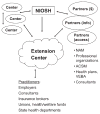Statement on national worklife priorities
- PMID: 20949545
- PMCID: PMC5860803
- DOI: 10.1002/ajim.20900
Statement on national worklife priorities
Abstract
The National Institute for Occupational Safety and Health (NIOSH) WorkLife Initiative (WLI) [http://www.cdc.gov/niosh/worklife] seeks to promote workplace programs, policies, and practices that result in healthier, more productive employees through a focus simultaneously on disease prevention, health promotion, and accommodations to age, family, and life stage. The Initiative incorporates the Institute's foundational commitment to workplaces free of recognized hazards into broader consideration of the factors that affect worker health and wellbeing. Workplace hazards, such as physical demands, chemical exposures, and work organization, often interact with non-work factors such as family demands and health behaviors to increase health and safety risks. New workplace interventions being tested by the first three NIOSH WLI Centers of WorkLife Excellence are exploring innovative models for employee health programs to reduce the human, social, and economic costs of compromised health and quality of life. Many parties in industry, labor, and government share the goals of improving employee health while controlling health care costs. NIOSH convened a workshop in 2008 with representatives of the three Centers of Excellence to develop a comprehensive, long-range strategy for advancing the WorkLife Initiative. The recommendations below fall into three areas: practice, research, and policy. Responding to these recommendations would permit the WorkLife Center system to establish a new infrastructure for workplace prevention programs by compiling and disseminating the innovative practices being developed and tested at the Centers, and elsewhere. The WLI would also extend the customary scope of NIOSH by engaging with multiple NIH Institutes that are already generating research-to-practice programs involving the working-age population, in areas such as chronic disease prevention and management. Research to Practice (r2p) is a concept focused on the translation of research findings, technologies, and information into evidence-based prevention practices and products that are adopted in the workplace or other "real-world" settings. NIOSH's goal is to overcome the translational issues that now prevent state-of-the-art occupational health, health promotion, and chronic disease research findings from benefiting working age populations immediately, regardless of workplace size, work sector, or region of the country.
2010 Wiley-Liss, Inc.
Figures

References
-
- Albertsen K, Borg V, Oldenburg B. A systematic review of the impact of work environment on smoking cessation, relapse and amount smoked. Prev Med. 2006;43:291–305. - PubMed
-
- Aldana SG. Financial impact of health promotion programs: A comprehensive review of the literature. Am J Health Promot. 2001;15:296–320. - PubMed
-
- Baker E, Israel B, Schurman S. The integrated model: Implications for worksite health promotion and occupational health and safety practice. Health Educ Q. 1996;23:175–188. - PubMed
-
- Barbeau E, Roelofs C, Youngstrom R, Sorensen G, Stoddard A, Lamontagne AD. Assessment of occupational safety and health programs in small businesses. Am J Ind Med. 2004;45:371–379. - PubMed
-
- Blewett V, Shaw A. Health promotion, handle with care: Issues for health promotion in the workplace. J Occup Health Saf. 1995;11:461–465.
Publication types
MeSH terms
Grants and funding
LinkOut - more resources
Full Text Sources

